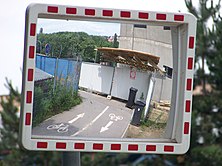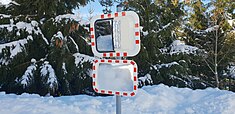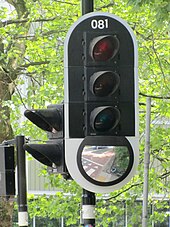Traffic mirror
Traffic mirrors are permanently installed convex mirrors and are part of the street equipment . They are mainly used in the area of confusing junctions, curves or property exits and are intended to improve visibility there . Whether traffic mirrors actually make a contribution to road safety is controversial due to various disadvantages in the professional world.
functionality
The appearance of traffic mirrors is not standardized. Traffic mirrors usually consist of a convexly curved mirror surface that is attached to a rectangular or round carrier plate. For safety reasons, mirror glass is usually not used for this , but a mirror film. Many mirrors have a conspicuous marking on the edge for better visibility (mostly red and white or black and white). Fogging up and freezing of traffic mirrors can be reduced or even completely prevented by taking certain precautions. For example, manufacturers offer mirrors that have a specially coated mirror surface, thermal insulation with antifreeze or electrical heating.
The mirror is set up and aligned in such a way that the line of sight of the (waiting) road user is directed directly into the poorly visible street area. In this way, he can see other road users earlier without having to drive into the area himself.
criticism
Practice has shown that various disadvantages arise when using traffic mirrors. The effectiveness of traffic mirrors is therefore controversial among experts. On the part of the critics, among other things, it is stated that traffic mirrors only simulate safety for road users, even though it actually does not exist. For many road construction authorities , these disadvantages have resulted in traffic mirrors either only being approved in individual cases or not at all. The following disadvantages are known:
- Susceptibility to pollution from environmental influences (such as dirt or water or ice) or vandalism (e.g. from stickers or graffiti)
- Distorted and reduced mirror image (risk of misinterpretation of the traffic situation)
- Ineffectiveness due to accidental or deliberate twisting
- Danger of glare from headlights or direct sunlight
- Creation of blind spots in the mirror image (cyclists and pedestrians can be overlooked)
Fog-free and ice-free traffic mirrors
During the cold season of the year, conventional traffic mirrors tend to fog up or even ice up. Heated mirrors, on the other hand, rarely provide a remedy because there is often no power connection available in remote locations and it would take a lot of effort to install. For this reason, anti-condensation and anti-icing protection was developed that works without a power connection. The housing temperature is controlled by embedded cavities, foams and gel cushions between the mirror surface and the rear wall in such a way that condensation or ice build-up is prevented, even at temperatures below −20 ° C.
Legal regulations in DA-CH
Traffic mirrors are not listed as traffic signs or traffic facilities in either the German road traffic regulations or the Swiss traffic regulations . Only in Austria are traffic mirrors according to Section 31 of the Road Traffic Act 1960 among the facilities for regulating and securing traffic .
The erection of a traffic mirror on public traffic ground must be requested from the road construction agency, the costs of acquisition and maintenance must be borne by the applicant. From the point of view of road traffic law, the traffic mirror is only an aid, the basic duty of care (for example according to § 10 when driving out of a property) still applies. In case of doubt, the road user who has to wait must carefully feel their way into the area or be instructed.
“A traffic mirror is not a traffic sign. It is intended to make it easier for those subject to waiting to feel into an intersection or a junction area, but does not exempt them from orienting themselves about the traffic situation immediately before entering the priority road. "
"Measures against fogging or icing of the mirrors are not prescribed."
Trixi mirror
The so-called Trixi mirror is a special form of the traffic mirror . The mirror is named after the daughter of the inventor Ulrich Willburger. He developed this special mirror after his daughter Beatrix was hit by a truck in a turning accident in 1994 and was seriously injured.
The Trixi mirror is a small convex mirror that is attached directly to the signal head of a traffic light system . It is used to reduce the blind spot when turning large vehicles as much as possible and thus improve the view of pedestrians and cyclists. Cities that installed the mirrors at accident-prone nodes as part of a pilot project reported a decline in the number of accidents.
See also
- Memorial monument - memorial made of traffic mirrors
Web links
Individual evidence
- ↑ Statement by the Munich Building Department on the installation of traffic mirrors, 2010 (PDF)
- ↑ Press release on applying for traffic mirrors. District Office Reinickendorf in Berlin.
- ^ Roseman Compendium . Kuratorium für Verkehrssicherheit, Vienna 2012, ISBN 978-3-7070-0109-9 , p. 130, kfv.at ( Memento of the original from September 3, 2014 in the Internet Archive ) Info: The archive link was inserted automatically and has not yet been checked. Please check the original and archive link according to the instructions and then remove this notice. (PDF)
- ^ Spiegel Lux. In: Manufacturer's website. Retrieved March 12, 2019 (German, English, French).
- ^ Higher Regional Court Karlsruhe, VRS 1980, 1172, sichestrassen.de
- ↑ OLG Frankfurt, NZV 1989, 191 , afe streets.de
- ^ Willburger GmbH with their Trixi mirror
- ↑ The fight against turning accidents . In: Süddeutsche Zeitung , June 26, 2013
- ^ Research project Trixi-Spiegel of the Technical University of Kaiserslautern




